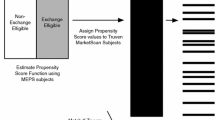Abstract
Risk adjustment may be a sensible strategy to reduce selection bias because it links managed care payment directly to the costs of providing services. In this paper we compare risk adjustment models in two populations (public employees and their dependents, and publicly-insured low income individuals with disabilities) in Washington State using two statistical approaches and three health status measures. We conclude that a two-part logistic/GLM statistical model performs better in populations with large numbers of individuals who do not use health services. This model was successfully implemented in the employed population, but the managed care program for the publicly insured population was terminated before risk adjustment could be applied. The choice of the most appropriate health status measure depends on purchasers' principles and desired outcomes.
Similar content being viewed by others
References
H. Aikaike, Information theory and an extension of the maximumlikelihood principle, in: 2nd International Symposium on Information Theory, eds. B.N. Petrov and F. Csaki (Akademia Kiado, Budapest, 1973) pp. 267–281.
A.F. Ash, F. Porell, L. Gruenberg, E. Sawitz and A. Beiser, Adjusting Medicare capitation payments using prior hospitalization data, Health Care Financing Review 10(4) (1989) 17–29.
J. Beyer, Letter to health plans, Medical Assistance Administration, Olympia, WA (1997).
D.K. Blough, C.W. Madden and M.C. Hornbrook, Modeling risk adjustment using generalized linear models, Journal of Health Economics 18 (1999) 153–171.
N. Duan, W.G. Manning Jr., C.N. Morris and J.P. Newhouse, Choosing between the Sample-Selection model and the Multi-Part model, Journal of Business and Economic Statistics 2(3) (1984) 283–289.
R.P. Ellis and A. Ash, Refinements to the Diagnostic Cost Group (DCG) model, Inquiry 32 (1995) 418–429.
R. Ellis, G. Pope, L. Iezzoni, J. Ayanian, D. Bates, H. Burstin and A. Ash, Diagnosis-based risk adjustment for Medicare capitation payments, Health Care Financing Review 12(3) (1996) 101–128.
J.B. Fowles, J.P. Weiner, D. Knutson, E. Fowler, A.M. Tucker and M. Ireland, Taking health status into account when setting capitation rates: a comparison of risk-adjustment models, Journal of the American Medical Association 276(16) (1996) 1316–1321.
R. Glasser, The doctor is not in: On the managed failure of managed care, Harpers (March 1998) 35–41.
M.C. Hornbrook and M.J. Goodman, Assessing relative health plan risk with the RAND-36 health survey, Inquiry 32 (1995) 56–74.
R. Kronick, T. Dreyfus, L. Lee and Z. Zhiyuan, Diagnostic risk adjustment for Medicaid: The disability payment system, Health Care Financing Review 12(3) (1996) 7–33.
C.W. Madden and G. Christenson, Implementing health status-based risk adjustment in an employed population: Final report for the Robert Wood Johnson Foundation, University of Washington, Seattle, WA (1998).
C.W. Madden, S.M. Skillman and B.P. MacKay, Risk Distribution and Risk Assessment Among Enrollees in Washington State's Medicaid SSI Population (Center for Health Care Strategies, Princeton, NJ, 1999).
C.W. Madden, M.T. Stanley, S.M. Skillman, D.K. Blough, B.P. MacKay, V. Wilson, S. Kilby, M.C. Hornbrook, M. Goodman, G.D. Bennett and L. Dey, Risk distribution among competing health plans: Phase I final report, University of Washington. Seattle, WA (1995).
W.G. Manning, N. Duan and W.H. Rogers, Monte Carlo evidence on the choice between sample selection and two-part models, Journal of Econometrics 35 (1987) 59–82.
W.G. Manning, The logged dependent variable, heteroscedasticity and the retransformation problem, Journal of Health Economics 17(3) (1998) 283–295.
J. Mullaly, Much ado about two: Reconsidering retransformation and the two-part model in health econometrics, Journal of Health Economics 17(3) (1998) 247–281
N.J. Naglekerke, A two page note on a generalized R 2, Biometrika 78(3) (1991) 691–692.
B. Starfield, J. Weiner, L. Mumford and D. Steinwachs, Ambulatory care groups: A categorization of diagnoses for research and management, Health Services Research 26(1) (1991) 54–74.
J.P. Weiner, A. Dobson, S. Maxwell, K. Coleman, B. Starfield and G. Anderson, Risk-adjusted Medicare capitation rates using ambulatory and inpatient diagnoses, Health Care Financing Review 12(3) (1996) 77–99.
J.P. Weiner, B.H. Starfield, D.M. Steinwachs and L.M. Mumford, Development and application of a population-oriented measure of ambulatory care case-mix, Medical Care 29(5) (1991) 452–472.
V.M. Wilson, C.A. Smith, J.M. Hamilton, C.W. Madden, S.M. Skillman, B. MacKay, J.S. Matthiesen and D.A. Frazzini, Case study: The Washington state health care authority, Inquiry 35 (1998) 178–192.
Author information
Authors and Affiliations
Rights and permissions
About this article
Cite this article
Madden, C.W., Mackay, B.P., Skillman, S.M. et al. Risk adjusting capitation: Applications in employed and disabled populations. Health Care Management Science 3, 101–109 (2000). https://doi.org/10.1023/A:1019085122553
Issue Date:
DOI: https://doi.org/10.1023/A:1019085122553




